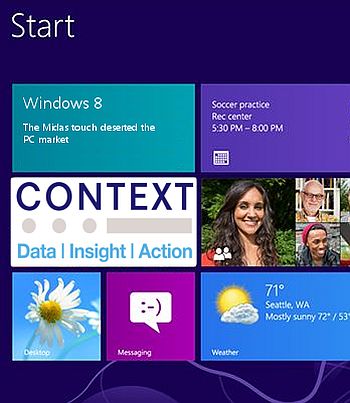Windows 8 Failures Stopped PC Markets From Thriving, Says Report

Tablets caused the decline of the PC but Windows marketing failures helped, too
Computer manufacturers, distributors, resellers and retailers screwed up their chances of a mini revival of the PC market by mishandling the launch of Windows 8, according to a Context market report.
The latest study of Western European distribution data shows that all PC form factors continued to decline in the early second quarter of 2013. But there are signs that the launch of Windows 8 could have rejuvenated the genre, if the products had been marketed more skilfully, said Context analysts.
Do not touch
“Demand for Windows 8 was not channelled particularly skilfully; with mixed press prior to launch, insufficient marketing activity at store level, and scant availability of touch systems,” said Marie-Christine Pygott, senior PC analyst at Context.
As a result the decline in the PC market was more dramatic than it needed to be. There had been positive signs over the period studied, with clamshell notebooks sales holding up, though still showing a small drop in sales figures.
However, the Windows 7/Windows 8 step-up scheme was a hit with customers. This offered a free licence upgrade to the new operating system for those investing in pre-installed Windows 7 and created a surge in demand, said the analyst, reporting an adoption rate for Windows 8 in the Windows consumer segment that reached 95 percent by mid-May across Western Europe.
Samsung, HP, Sony and Toshiba achieved the highest Windows 8 shares in their Windows consumer portfolios in mid-May. But the potency of Windows 8 as a PC flagship was undermined by the clumsy way in which channel marketing was conducted, says Context.
“The low availability of attractively priced Windows 8 touch products on retail shelves had a negative impact on sales,” said the study. “Retailers reported a poor Windows 8 user experience on the shop floor.”
In a related report, Context reveals that only four percent of Windows 8 Home clamshell-style notebooks sold across Western European distribution featured a touch screen in the first two months of Q2 2013. This, the analysts said, may be due to the cost-differential, with touch-enabled Windows 8 consumer laptops selling at an average distributor price of €528 (£450) in early Q2 13, while non-touch systems sold for €392 (£335).
While Context expects an increase in touchscreen availability in these traditional notebook as the year progresses and prices fall, stronger growth is expected in the hybrid notebook/tablet combination models as new products appear and taje advantage of the anticipated drop in pricing.